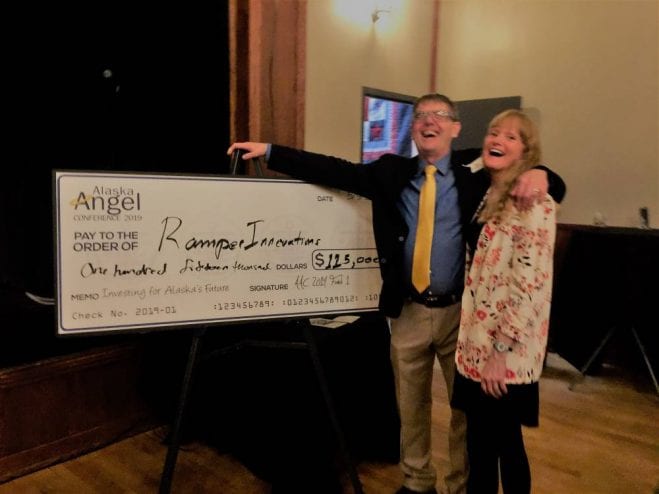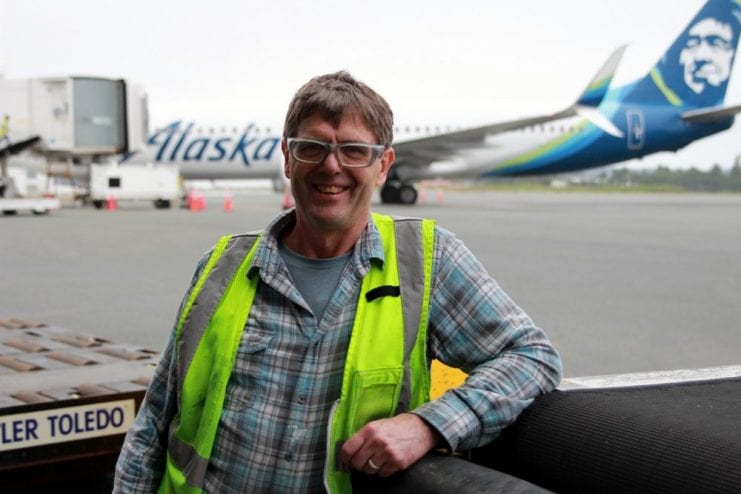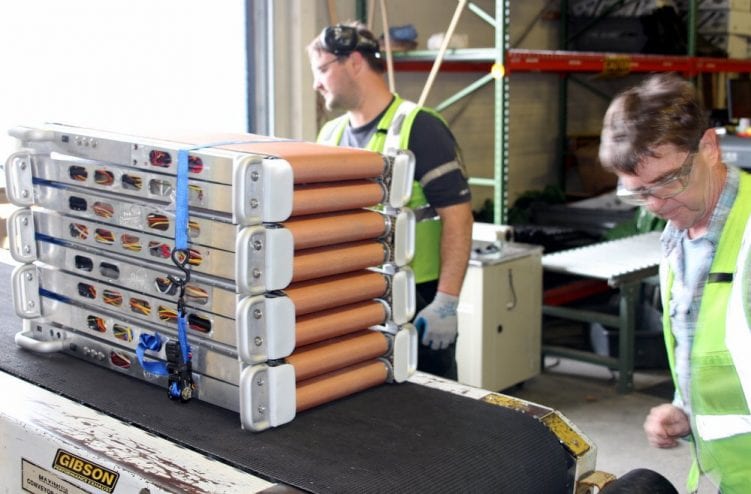
A Sitka startup is getting some traction in Alaska’s investment community.
The Alaska Angel Conference last week (5-9-19) awarded $115,000 in operating capital to Sitka-based Ramper Innovations.
That pushes investment in the airline ground service company to over a quarter-million dollars in less than a year.
Tim Fulton’s invention has been over thirty years in the making: an ingenious, folding conveyor belt that luggage handlers can use to move bags inside the ever-growing bellies of the world airline fleet.
TISABAS — short for TIm SAves BAckS — is now with a conveyor engineering firm in Wisconsin (CTW in Neenah, WI) having its parts, which Fulton designed in his Sitka garage, spec’d for manufacture.
One will be assembled and tested in late May.
“And if it passes the bench test, we’ll actually be producing the product within 4-6 weeks,” Fulton said.

The engineering firm will make just three of the TISABAS luggage conveyors, which will be sent to different test markets, says Fulton. After that, Fulton says his fledgling company will be at a crossroads. Scale up manufacture of TISABAS in Wisconsin, or look for larger possibilities.
“We emerge out of the contract with the rights to all of the drawings so we can take it forward to other places to manufacture for us if we need to scale up more, whatever that may look like,” said Fulton.
What it could look like is basically one of three possibilities: Ramper Innovations receives a major product order, it licenses the product to another company, or it enters into a distribution agreement.
All three of them are exciting to Steven Strickler, one of 21 investors with the Alaska Angels who backed Fulton. The Angels bought a 4-percent stake in Ramper Innovations at its conference May 9 in Anchorage, after a four-month review process that resembles a tamer version of television’s “Shark Tank.”
Strickler, a Juneau physician, spearheaded the exhaustive investigation that led to Fulton’s selection over four other new companies.
“We review his product, we review his advisors and his team, we review the competition he may have in this arena, and especially with him what type of experience does he have,” he said. “People all get these great ideas, but they don’t have any practical world experience.”

The fact that Fulton spent over three decades at Alaska Airlines loading luggage actually inspires confidence in Strickler and the other Angel investors. So do Fulton’s previous efforts to build plastic rollers to ease the backbreaking work of rampers on their knees sliding or throwing 70-lb fish boxes and other heavy bags 20 or more feet down the length of a plane’s belly.
Strickler believes that TISABAS could ride a wave of growth of the airline industry — across the world.
“It’s a very intriguing and exciting product,” said Strickler. “We’re confident as a group that this will gain great traction and really help solve problems for a lot of ground services — not only for turnaround time, that’s what the airlines and airports desire — but also for keeping the ramp workers in good shape so they don’t become injured.”
The investment by Strickler and the other Alaska Angels in Ramper Innovations was the result of legislation passed in 2012 under the Obama Administration called the Jumpstart Our Business Startups — or the JOBS Act. The legislation relaxed securities regulations, and allowed companies to use crowdfunding to issue securities. The most well-known result was the Kickstarter website, but Alaska Angels were formed along the same lines — with the Shark Tank-style vetting process described earlier.
And even if it were the actual Shark Tank, Fulton might have done pretty well. TISABAS did not roll out of his garage overnight; it is the result of years of attempts and failures — and Strickler says this is another winning point for Fulton.
“He has this grit that just says ‘I’m going to figure this out –I’m going to keep doing this,” Strickler said of Fulton.
And while Fulton has surrounded himself with the minds that can make TISABAS a reality — a strategy team, cpa’s, industry advisors, and of course lawyers — his mind is already cutting new trail toward… something.
“I was out at the airport last night making some measurements for the next potential product,” he said, laughing.
So far Fulton has raised over $250,000 in investment for Ramper Innovations — $150,000 of it from local Sitkans. But Fulton credits the support of his top investor — his wife, Leslie — for keeping the company going. “We haven’t had a paycheck yet,” says Fulton. “Right now we’re running on passion.”































